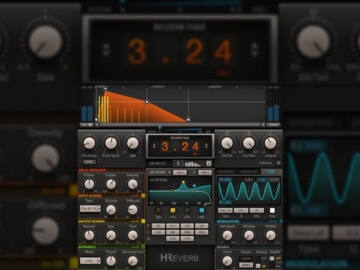

Audio mixing is a critical stage of music production, where audio components are blended to create the final product. However, mixing music can be tricky for beginners or those who fail to notice small details in this phase. To help you get the most out of your music and produce professional-level tracks, we've compiled a list of 6 common mixing mistakes you should avoid at all costs. Read on for our essential checklist before sending off those tracks!
One of the primary mixing mistakes many sound engineers commit is not having a clear idea of their goals. Before you start mixing, you need to define an objective. Does the track need to have a natural and organic sound, or does it need heavy processing for a more surreal feel? Are there certain instruments you want to emphasize or de-emphasize?
If you don't have a clear idea of what you want to achieve in your mix, you will have difficulty getting there. Not having a defined objective can make you feel lost and unclear about what to do to get your mix on track. That's why defining your music mixing goals is essential before you start.
Take the time to sit down and listen to the tracks you'll be working on in detail. Analyze every element, from the drums to the bass guitar to the vocals. Use high-quality headphones or speakers to hear ever little nuance of the tracks. Once you have a good idea of what you want to accomplish with your mix, it will be much easier to achieve your vision.
The most important thing is to avoid rummaging around unnecessarily without a clear sense of what you're looking for. Otherwise, your music mixing will suffer, and you'll feel frustrated. So, if you are serious about getting a good mix, start by setting your goals first. A great mixing engineer always has a clear idea of what they are doing.
Related Article: What Is Mixing In Music And Why It's Important For You To Know?

Mixing music too loud is one of the most common mixing mistakes. Whether it's due to poor monitoring, lack of experience, or the excitement of a new mix, the unexperienced tend to push levels to the limit, resulting in a result that lacks dynamic range and clarity.
Mixing music too loud can have serious consequences. Excessive levels can lead to various issues, from listener fatigue and hearing damage to poor translation on different playback systems. Moreover, it will drastically affect what a mastering engineer can do with it resulting in a lower quality end product.
To avoid mixing too loud, there are several strategies you can adopt. First, establish a good monitoring system and calibrate your levels to ensure you mix comfortably and accurately. This will allow you to hear all the details and nuances of your mix without overcompensating for inaccuracies.
Second, use headroom wisely. Rather than pushing all your faders and plugins to the limit, leave some headroom and use compression, limiting, and other dynamics processing techniques to control the peaks and balance the dynamics. This will produce a more natural sound, with better transparency and less distortion.
Third, trust your ears. Don't rely too much on meters and visual aids; instead, use your ears to evaluate your mix's balance, tonality, and impact. Listen to your tracks on different playback systems and in different environments to identify any issues that need to be addressed.
You can always try a music mixing online service to assist you in the process.
When you start mixing music, it is important to maintain a delicate balance between using enough effects to enhance the sound and too much to create an audio mess. One of the most common mixing mistakes beginner make is using too many master bus effects.
Master or global effects are applied to an entire mix rather than specific individual tracks. While they can be used to great effect, particularly in areas such as equalization and compression, it is important to remember that less can be more. It is often best to leave your mix bus free of effects so that audio mastering services will have greater flexibility.
Additionally, stacking too many effects can impact the mix's overall clarity and dynamic range, resulting in a loss of fidelity and decreased listening quality. This is particularly true when using effects such as reverb and delay, which can cause the mix to sound washed out or muddy if not used sparingly.
When working with effects in general, it is important to consider the mix's overall sound and use them only when necessary.

Reverb is an essential tool in mixing music as it helps create a sense of space and depth. However, using too much reverb can significantly affect the quality of the final mix. When too much reverb is used, it can result in a muddy and indistinct sound that lacks clarity and definition.
There are several reasons why some audio engineers tend to overdo it with reverb. One reason is that they try to compensate for poor recording conditions by adding more reverb to give the impression of a more polished sound. Another reason is that some mixers generally think a lot of reverb sounds good. This is where you can tell the pro from the amateur.
To avoid using too much reverb, it is essential to understand the purpose of the effect and use it judiciously. The best approach is to use one room reverb and put all the tracks in it. This will make all the instruments sound like they were recorded in the same room giving them a cohesive feel.
Another technique is to use more intricate reverbs on instruments you want to stand out. For example, using a plate reverb on lead vocals or a snare drum, will set them apart in the mix. This can be used on top of the room reverb.
Avoiding too much reverb is critical to producing a professional mix. By understanding its purpose, you can achieve a more cohesive mix and enhance the overall quality of the recording.
Mixing is the art of blending multiple audio tracks to create a harmonious and uniform sound. When it comes to mixing, the phase relationship is a critical factor that should never be ignored. In simple terms, phase refers to the timing relationship between audio signals. Phase relationship problems can cause audio-related issues, such as bass cancellation, frequency masking, and stereo image deterioration.
One example of phase relationship problems is when 2 microphones pick up the same audio source, such as a guitar amplifier. If the microphones are not positioned correctly, they may pick up the sound waves out of phase, causing a comb filtering effect, which results in a thin and weak sound.
Additionally, the time alignment between tracks in your mix significantly impacts how they interact with each other. Therefore, checking your mix for phase issues throughout the process or using a phase correlation meter is essential.
Related Article: What Is Phase Cancellation? Don’t Let It Ruin Your Recordings!

Low-frequency sound waves can be problematic when recording and mixing audio. These waves can interfere with other instruments and vocals, resulting in a muddy or boomy sound. It's crucial to manage the frequency spectrum to ensure clarity and balance in your mix.
To control the low end, you can use a high-pass filter to remove inaudible frequencies from each track. Setting the high-pass filter frequency usually depends on the type of instrument and its role in the mix. For example, a bass guitar might be filtered at 40 Hz, while a kick drum might be filtered at 80 Hz.
Additionally, using bass traps in your recording space can help reduce low-frequency standing waves that cause an uneven bass response in the room.
Mixing, like any skill, takes time and practice to perfect. While it is normal to make mistakes throughout the process, there are some mistakes that should be avoided in order to ensure optimal sound quality. The six common mixing mistakes covered in this blog post are a great place to start in improving your music mixing and mastering skills.
However, as you continue to learn more about sound engineering and practices, it's important to remember that your ears should ultimately guide you in terms of evaluating the output of completed projects. So keep honing your craft, and never hesitate to experiment with different techniques so that you can create the best audio mixes possible!
"Some of the links within this article are affiliate links. These links are from various companies such as Amazon. This means if you click on any of these links and purchase the item or service, I will receive an affiliate commission. This is at no cost to you and the money gets invested back into Audio Sorcerer LLC."